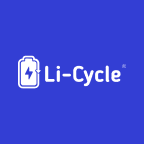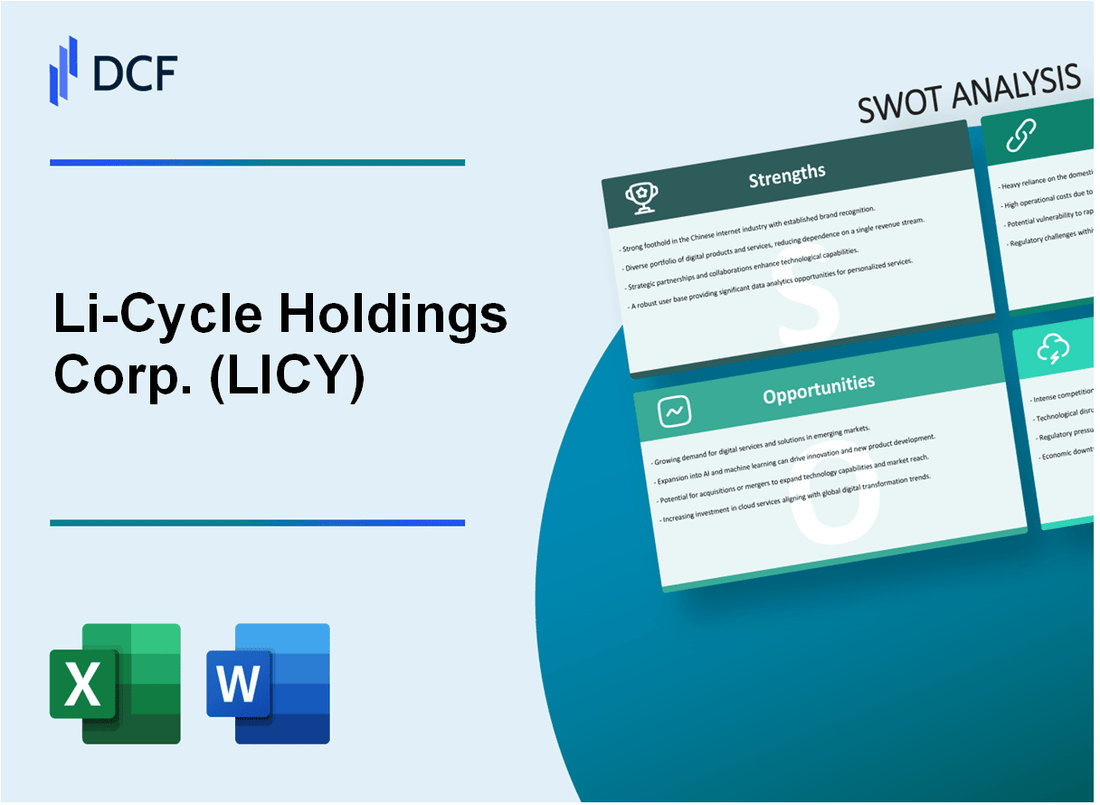
|
Li-Cycle Holdings Corp. (LICY): SWOT Analysis [Jan-2025 Updated] |

Fully Editable: Tailor To Your Needs In Excel Or Sheets
Professional Design: Trusted, Industry-Standard Templates
Investor-Approved Valuation Models
MAC/PC Compatible, Fully Unlocked
No Expertise Is Needed; Easy To Follow
Li-Cycle Holdings Corp. (LICY) Bundle
In the rapidly evolving landscape of battery recycling, Li-Cycle Holdings Corp. (LICY) emerges as a critical player transforming the electric vehicle and renewable energy ecosystem. As global demand for sustainable battery solutions skyrockets, this innovative company stands at the intersection of technological advancement, environmental responsibility, and strategic market positioning. Our comprehensive SWOT analysis unveils the intricate dynamics driving Li-Cycle's potential to revolutionize critical mineral recovery and contribute to a more sustainable future, offering investors and industry observers a deep dive into the company's competitive landscape and strategic potential.
Li-Cycle Holdings Corp. (LICY) - SWOT Analysis: Strengths
Pioneering Battery Recycling Technology
Li-Cycle operates with advanced hydrometallurgical processing capabilities that enable battery recycling efficiency. The company's proprietary technology can recover up to 95% of critical battery materials, including lithium, nickel, cobalt, and manganese.
| Technology Metric | Performance Data |
|---|---|
| Material Recovery Rate | 95% |
| Processing Capacity | 35,000 tons of batteries annually |
| Carbon Emission Reduction | 75% compared to virgin material production |
Strategic Partnerships
Li-Cycle has established critical partnerships with major industry players.
- Ultium Cells (GM joint venture)
- Agco Corporation
- Volkswagen Group
- Stellantis
Vertically Integrated Business Model
The company's comprehensive approach covers multiple stages of battery recycling:
| Business Stage | Operational Capability |
|---|---|
| Battery Collection | North American network of collection points |
| Processing | 2 commercial-scale facilities |
| Material Production | Direct supply to battery manufacturers |
Environmental Impact
Li-Cycle's recycling process demonstrates significant environmental benefits:
- Reduces mining demand for critical minerals
- Prevents battery waste in landfills
- Lowers greenhouse gas emissions
North American Infrastructure
Current operational facilities include:
| Location | Facility Type | Processing Capacity |
|---|---|---|
| Rochester, NY | Commercial Hub | 10,000 tons/year |
| Alabama | Commercial Hub | 25,000 tons/year |
| Ontario, Canada | Spoke Facility | 5,000 tons/year |
Li-Cycle Holdings Corp. (LICY) - SWOT Analysis: Weaknesses
Consistent Negative Financial Performance and Ongoing Operational Losses
Li-Cycle reported a net loss of $106.9 million for the fiscal year 2023, with total operating expenses of $152.5 million. The company's accumulated deficit stood at $441.2 million as of November 30, 2023.
| Financial Metric | 2023 Value |
|---|---|
| Net Loss | $106.9 million |
| Operating Expenses | $152.5 million |
| Accumulated Deficit | $441.2 million |
High Capital Expenditure Requirements for Expanding Recycling Infrastructure
The company has invested $375 million in capital expenditures for developing recycling facilities during 2022-2023. Planned infrastructure expansion requires significant additional funding.
- North American recycling hub in Rochester, NY: $175 million investment
- Strategic expansion in Norway: $85 million committed
- Projected infrastructure development costs: $250-300 million annually
Limited Geographic Presence
Current operational footprint covers only 3 countries: United States, Canada, and Norway, representing approximately 12% of the global battery recycling market.
| Region | Operational Status |
|---|---|
| North America | Primary operations |
| Europe | Limited presence (Norway) |
| Asia | No direct operations |
Dependence on Emerging Electric Vehicle and Renewable Energy Battery Markets
Battery recycling volume directly correlates with electric vehicle adoption rates. Global EV battery waste projected to reach 800,000 metric tons by 2025, creating market volatility.
Complex Regulatory Landscape
Compliance costs for battery recycling regulations estimated at $15-25 million annually. Regulatory complexity varies across jurisdictions, creating operational challenges.
- United States: EPA and state-level regulations
- European Union: Strict battery recycling directives
- Canada: Provincial environmental compliance requirements
Li-Cycle Holdings Corp. (LICY) - SWOT Analysis: Opportunities
Rapidly Expanding Electric Vehicle Market Driving Increased Battery Recycling Demand
Global electric vehicle (EV) battery market projected to reach $128.7 billion by 2027, with a CAGR of 25.3%. Lithium-ion battery demand expected to grow from 287 GWh in 2022 to 2,957 GWh by 2030.
| Region | EV Battery Demand (GWh) 2022 | Projected Demand (GWh) 2030 |
|---|---|---|
| China | 130 | 1,200 |
| Europe | 80 | 600 |
| North America | 50 | 500 |
Potential Government Incentives and Support for Sustainable Battery Supply Chains
U.S. Inflation Reduction Act allocates $369 billion for clean energy investments, with $7,500 tax credit per domestically recycled EV battery.
- European Union Battery Regulation mandates 70% recycling efficiency by 2030
- China targets 70% battery material recovery rate by 2025
Growing Emphasis on Circular Economy and Sustainable Manufacturing Practices
Global circular economy market expected to reach $4.5 trillion by 2030, with battery recycling representing $18 billion market segment.
Emerging Battery Material Recovery Technologies
| Material | Recovery Potential | Market Value |
|---|---|---|
| Lithium | 95% | $86,000/ton |
| Cobalt | 90% | $75,000/ton |
| Nickel | 85% | $45,000/ton |
Expanding Global Push for Reduced Carbon Emissions
Global carbon reduction targets require 45% emissions cut by 2030. Battery recycling can reduce carbon footprint by up to 70% compared to virgin material production.
- Paris Agreement signatories commit to net-zero emissions
- Corporate sustainability targets driving battery recycling investments
Li-Cycle Holdings Corp. (LICY) - SWOT Analysis: Threats
Intense Competition from Emerging Battery Recycling Technologies and Companies
As of Q4 2023, the global battery recycling market is projected to reach $18.1 billion by 2027, with multiple competitors emerging:
| Competitor | Market Presence | Annual Recycling Capacity |
|---|---|---|
| Redwood Materials | United States | 30,000 metric tons/year |
| Northvolt | Sweden | 50,000 metric tons/year |
| Li-Cycle | North America | 20,000 metric tons/year |
Potential Supply Chain Disruptions in Battery Collection and Processing
Supply chain risks in battery recycling include:
- Transportation logistics challenges
- Regulatory compliance complexities
- Limited battery collection infrastructure
Fluctuating Prices of Critical Battery Metals
Metal price volatility as of January 2024:
| Metal | Price Volatility (2023) | Current Price |
|---|---|---|
| Lithium | -40.5% | $14,500/metric ton |
| Nickel | -22.3% | $16,800/metric ton |
| Cobalt | -35.7% | $33,000/metric ton |
Technological Obsolescence Risk
Recycling technology evolution rates:
- Average technology lifecycle: 3-5 years
- R&D investment required: $50-75 million annually
- Emerging technologies: Hydrometallurgical and direct recycling methods
Potential Economic Downturns
Electric vehicle market indicators:
| Metric | 2023 Value | Projected 2024 Impact |
|---|---|---|
| Global EV Sales | 13.6 million units | Potential 5-10% slowdown |
| Battery Demand | 550 GWh | Potential reduction to 500 GWh |
| Investment Sentiment | Cautious | Reduced venture capital |
Disclaimer
All information, articles, and product details provided on this website are for general informational and educational purposes only. We do not claim any ownership over, nor do we intend to infringe upon, any trademarks, copyrights, logos, brand names, or other intellectual property mentioned or depicted on this site. Such intellectual property remains the property of its respective owners, and any references here are made solely for identification or informational purposes, without implying any affiliation, endorsement, or partnership.
We make no representations or warranties, express or implied, regarding the accuracy, completeness, or suitability of any content or products presented. Nothing on this website should be construed as legal, tax, investment, financial, medical, or other professional advice. In addition, no part of this site—including articles or product references—constitutes a solicitation, recommendation, endorsement, advertisement, or offer to buy or sell any securities, franchises, or other financial instruments, particularly in jurisdictions where such activity would be unlawful.
All content is of a general nature and may not address the specific circumstances of any individual or entity. It is not a substitute for professional advice or services. Any actions you take based on the information provided here are strictly at your own risk. You accept full responsibility for any decisions or outcomes arising from your use of this website and agree to release us from any liability in connection with your use of, or reliance upon, the content or products found herein.
